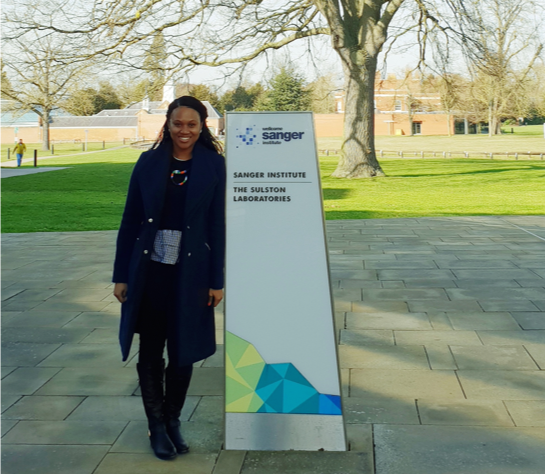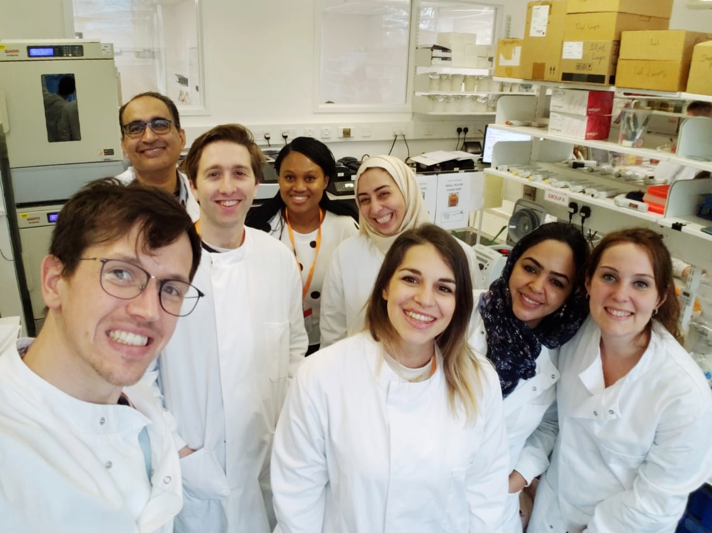A KRISPER at the Wellcome Sanger Institute
Author: Zandili Sibisi - 2019-05-01
Tweet
The assertion that the Wellcome Genome Campus (WGC) is home to some of the world's prominent institutes and organizations in genomics and computational biology is irrefutable. It is the base of the Sanger Institute, EMBL-EBI, Connecting Science, YourGenome and the BioData Innovation Centre. Sequencing 5,400 billion DNA bases every day, the campus is one of the largest concentrations of genomics and biodata in the world and it has been home to some of the most important genetic discoveries of the 20th and 21st Centuries. Amongst others, the site was the location where around one third of the human genome was sequenced, making it the biggest contributor to the Human Genome Project. Over the last five years, the institutes have produced a combined total of around 3,800 research papers; many of these are amongst the world's most cited papers. The campus brings together leading talent and supports its scientists and bioinformaticians with the best facilities, best services and fantastic learning and collaboration opportunities.
It was at the beginning of the festive season that I received the great news that my application to attend a WGC advanced course had been successful. My submission was chosen from many applicants by a stringent selection process, involving a highly regarded selection panel; I merrily accepted the invitation. Titled “WGC Advanced Course in Genomics and Clinical Virology”, the course description gave me an indication that the training offered would be beneficial for my writing and bioinformatics analysis. The course would combine practical, hands-on laboratory and bioinformatics work, lectures and discussions on the application of next generation sequencing technologies to clinical virology. Topics covered would include; next generation and third generation sequencing platforms, bioinformatics analysis including different viral genome assembly approaches, data interpretation, validation and accreditation of viral WGS diagnostic service, and case studies in outbreak investigation and infection control. It seemed well suited for my current research.
My PhD research project focuses on elucidating phylogenetic transmission networks in a hyper-endemic setting in South Africa. Using phylogenetic cluster analysis and combining it with epidemiological, demographic, and behavioural data, we are testing the hypothesis that age-disparate relationships are associated with an increased risk of HIV acquisition in young women. We are also addressing the notion that dense sequencing in real time and phylogenetic monitoring can be used to define the characteristics of individuals and sub-populations contributing disproportionally to transmission events and that such information can be used efficiently target HIV prevention intervention. I thus believed that the specific skills offered by this course would be very useful for my analysis.
Although limited to a time-constraint of six days, this course was well planned and we were able to grasp the basic principles of each technique taught. I am currently writing two papers that require analytical skills that were offered by this course. The first paper aims to characterize the utilization of the MinION sequencer in a resource-limited remote area to sequence full HIV genomes, as to establish real-time genomic surveillance of HIV in South Africa. The MinION sequence output is also being contrasted to the quality of Illumina full HIV genomes. As this course combined practical, hands-on laboratory and bioinformatics work on the application of Next Generation and MinION sequencing technologies to clinical virology, it provided the specific training and skills required for the execution my analysis.

Course participants from Canada, United Kingdom, Italy, South Sudan, Ireland, Argentina, Saudia Arabia and South Africa.
Being authors of a Nature publication based on the utilization of MinION sequencing, Dr. Joshua Quick and Dr. Nick Loman are probably the most qualified scientists to give laboratory training on this topic. We were very fortunate to be able to conduct the whole MinION sequencing pipeline under their expert instruction. Additionally, their current work focuses on the development and evaluation of novel sequencing and bioinformatics methods to aid the interpretation of genome data generated in public health microbiology, thus conversing with these scientists expanded my perspective on my paper. We systematically discussed technical aspects of the two sequencing platforms, thus the complexity of my comparison has been enriched. They also invited me to contact them if further assistance is required.
The second paper, titled “Who's infecting young women: Phylogenetic characterization of HIV transmission dynamics in KZN, South Africa”, aims to test the hypothesis that age-disparate relationships are associated with an increased risk of HIV acquisition in young South African women. It involves extensive analysis of high throughput data and phylogenetic cluster analysis and the course involved training in this specific area. In the course, participants gained practical experience in bioinformatics analysis of the output data with focus on reference mapping and de novo assembly approaches, and downstream analyses such as phylogenetic inference, this has been invaluable for my analysis. We also had informative seminars conducted by authors whose publications I read and cite frequently, such as Prof. Andrew Leigh Brown, Prof. Oliver Pybus and Dr. Chris Wymant, I believe that one on one sessions with these instructors were very useful. I also had a very interesting discussion with Prof. Oliver Pybus about the challenges ahead in genomic epidemiology. Additionally, Dr. Chris Wymant gave us a two-day practical on his Phyloscanner platform; it was like receiving piano lessons from Beethoven!
I am very thankful to my supervisor, Prof. Tulio de Oliveira, as well as SANTHE for affording me the opportunity to attend this course. The course involved specific one-off training in techniques currently being performed in the UK, which I will be able to transfer back to my research and fellow colleagues, I think this will be the realization of SANTHE's and KRISP's aims of capacity building.
Links:
KRISP has been created by the coordinated effort of the University of KwaZulu-Natal (UKZN), the Technology Innovation Agency (TIA) and the South African Medical Research Countil (SAMRC).
Location: K-RITH Tower Building
Nelson R Mandela School of Medicine, UKZN
719 Umbilo Road, Durban, South Africa.
Director: Prof. Tulio de Oliveira




